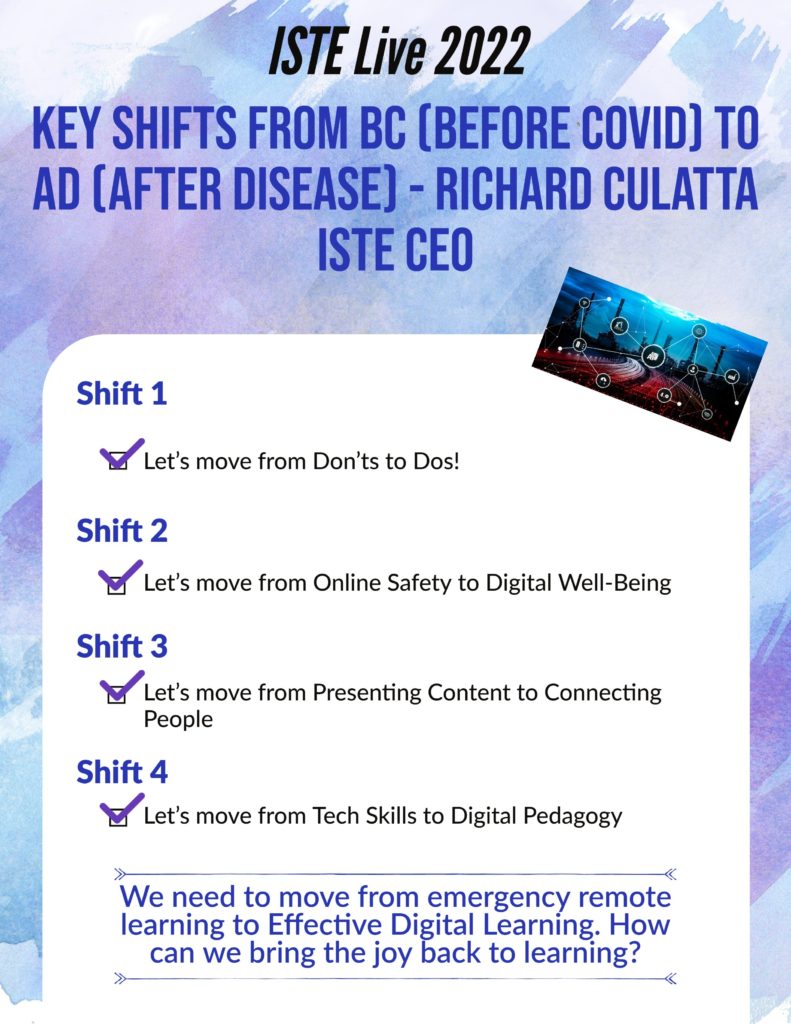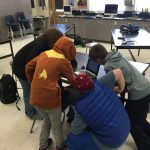
I thought it was just me. Just my students. Then I read this EdSurge article, Students Got a Crash Course in Tech During the Pandemic. Now Some Want a Break. I had been experiencing a bit of cognitive dissonance because I envisioned more and more teachers and students using tech in school because they experienced the power of tech during the pandemic. That turned out to be naïve wishful thinking on my part. The reality was that a majority of both teachers and students floundered with remote/online learning and instruction so both teachers and students got sick and tired of “screen time” for learning. As schools return to face-to-face instruction instead of teachers embracing new ways to integrate technology I’m hearing that there are those who are returning to non-tech methods of instruction and learning.
After two days of the NCCE22 EdTech conference and four days of the ISTE22 EdTech conference I kept hearing and learning more and more ways to use tech to engage and motivate students while providing them skills they will actually need for their futures. Throughout all that technology, I kept going back to this tech fatigue phenomenon and the return to a pre-COVID no tech education. As I heard presenters share how their tech tools provide students with hands-on practice and hands-on ways of creating, I kept going back to students in my class who would ask to do more actual hands-on learning INSTEAD of working on their laptops. While you are using your hands when on the computer, is it really that different to using your hands when writing on paper? We don’t consider writing hands-on, do we?
What students were telling me is that they wanted to do science experiments and to build physical models. Here I was attending conferences where I was learning about all these amazing tech tools for “hands-on learning” while the reality is that they are really not. I happen to agree, using a computer to learn and even to create is not as hands-on as say a makerspace – actually using your hands to make and build things. So I cannot consider all of the amazing ways we have to integrate technology as hands-on learning. Learning with technology is powerful and necessary, I just don’t see it as hands-on so I need to make sure I provide my students with actual hands-on learning experiences.
[Note: I pointed out to my students that WE did have hands-on activities. We did science labs, built solutions to problems using cardboard and tape, built displays on poster paper, and also learned outdoors in our creek and garden! In a blended learning environment we take advantage of the best digital learning AS WELL AS the best of physical in-person learning. So I told my students that we didn’t limit ourselves to one or the other – we did it all!]
Have you experienced tech fatigue in your students? Have you noticed tech fatigue in your staff/colleagues? Let us know by sharing in the comments.
During ISTE I posed the tech fatigue question in the Education Leaders chat. I also posed the same question in the ISTE Connects website as a new discussion topic in the commons. I got confirmation that I was not alone. Other schools and districts are currently experiencing tech fatigue and reverting back to educating our children without using technology. In one school the teacher noticed that her colleagues went back to using paper packets. That made my heart sink. I know kids got tired of spending all day in front of their screens, something that I do NOT agree with, but I also know that kids did not like paper packets much better! Some teachers even got pushback from their administration! IMHO I see that as a lack of vision.
We do not fix the inequities and shortcomings of poorly designed online teaching by throwing out technology completely. We fix the inequities and shortcomings by designing powerful learning opportunities that incorporate best in-person teaching practices alongside best EdTech teaching practices – ie. blended learning. Add to that deliberately using UDL (Universal Design for Learning) and you create INCLUSIVE learning environments.
In our ISTE Connects discussion forum, we agreed that what is needed is balance. We can’t go all digital and have kids back on screens all day at school (which NEVER should have happened that way when kids were remote learning, btw) but neither should we go back to having kids complete all non-tech activities all day. If our kids are ONLY using technology when they are at home then we lose out on teaching them how to be caring digital citizens in their online communities. We know that there is too much hate and bullying going on is our digital communities!
I think back to the time we spent learning remotely, either full time or part time when we returned with a hybrid schedule of part time learning in school and the rest of the time learning at home. Like many educators worldwide, I found that very few kids actually kept up with their work. We made sure to limit our synchronous instruction to about an hour in the morning and an hour in the afternoon with open office hour times. That allowed kids to work on their assignments when convenient for them while also providing them ways to get support anytime they needed it. We still didn’t get much work getting completed even when we returned to a hybrid schedule – most of the work completed during our hybrid schedule was done when in class. We provided every child a Windows 10 laptop and where needed either a hotspot or free Wifi. Still, work was just not getting done. So what were kids doing with their laptops and internet connectivity? Three things I know for sure include watching videos on YouTube or Tik Tok, gaming, and using something like Discord. Let’s unpack that. What was so enticing about using technology for watching videos, gaming, and Discord when I was providing them video lessons, Minecraft lessons, and LMS messaging??
YouTube and Tik Tok were probably mostly used to passively consume content but I saw some kids were also using those media to create their own content. Some even published their own work on a personal YouTube channel. Hm, that’s pretty high on Blooms Taxonomy for the kids who were creating content.
Gaming. Kids were playing games, not just for fun, but also to CONNECT with their friends and to make new friends with similar interests. Connecting, that’s one of the 21st Century C’s.
Discord. What did kids do on Discord? Communicate and connect. Again, they were using 21st Century skills on their own – without any prompting from us.
So even though I thought I was tapping into what motivates and engages students, video content, game-based learning, and ways to connect and communicate, they did those things for topics they were interested in and not necessarily the topics my curriculum was assigning them. Like a friend of mine always says, “we don’t get to choose what motivates kids,” Tammie Schrader. But we can use what motivates kids to engage kids in learning the content we are teaching.
So what does all this tell me?
- Balance is key. Blended Learning can provide that balance. It’s not about screen time – it’s about what we’re asking kids to do with their screen time! I am not advocating for throwing out physical, non-tech activities.
- Even though kids spend lots of time watching videos on YouTube and Tik Tok, my instructional videos will NOT compete with those. So for those of us who are flipping our instruction we need to provide time IN CLASS for kids to watch the videos. Plus, in class I can remind kids to WATCH, PAUSE, and DO something like sketchnoting regularly instead of just sitting there while my instructional video is playing and they aren’t even paying attention!
- Provide kids choice in what they learn and how they show understanding of what they learn. And yes, that does include non-digital ways of showing learning. Kids are motivated to learn thing that THEY are interested in and not always what we tell them they need to learn. Again, balance is helpful here, too.
- Getting kids creating content of their own and publishing is a time well spent on the computer.
- Gaming, or rather Game-Based Learning, has the potential to revolutionize education. The gaming industry is mega huge because of the power of gaming to motivate, excite, and connect us. Gaming is also participatory as opposed to spectatorial (passively consuming content). Still need convincing? Watch this video: An Invitation to Play: Why Games? Why Now?
- Speaking of connecting and communicating, group work allows kids to work together to solve problems. We need to remember to provide our students opportunities to not just present with technology but also to connect with others, even others outside our classrooms!
One of ISTE 22’s opening keynotes Sunday evening was given by ISTE’s CEO, Richard Culatta. I was inspired by his message. He encouraged us to move from emergency remote teaching to effective digital learning! And after all the trauma of COVID, he asked us how we plan on bringing the JOY back to our classrooms. He focused on four shifts that we need to make. I tried to capture those in the graphic below:
Richard wrote a book, Digital for Good: Raising Kids to Thrive in an Online World. I had to get it and I read most of it before ISTE22 came to an end! I highly recommend it! In his book Richard points to the fact that all the increased access to internet connectivity is providing us a unique opportunity, that won’t last if we fail to act now, to teach and model digital citizenship to provide our youth norms for how to act in online spaces. Richard points out that teaching and modeling how to be kind and friendly in online spaces, needs to be taught in those spaces. “Cognitive research has shown us that we learn most effectively when we are taught in the context where we will use the knowledge.” It’s definitely worth reading.
So how are you going to deal with tech fatigue in your classes? In your school or district? And how will you bring back the joy to learning?





















































